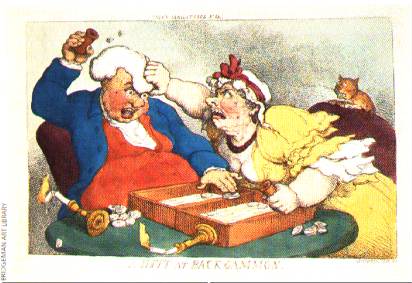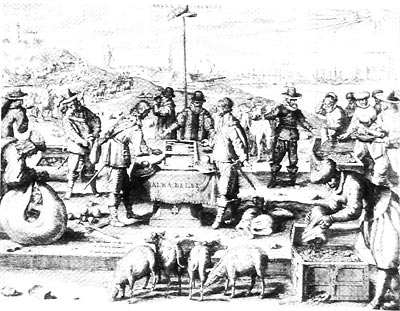![]()
web/turnbased backgammon, tournament style and 'friendlies' with a great community and additional 'theme
tournaments':
Nordic, Whiner's [antigammon], DG Team Tourney, European Cup - I'm Algeria

Richard's PBeM Server - a plefora of board games and
tournaments. Including the ones with webpages here [see box right --> ]
![]()
The Greek Tavli Server - to get to play plakoto and
fevga.
Cafe Cup 2004 - Danish Backgammon Federation. In 2002 [photo] I didn't qualify to go to the World Cup in Monaco (just like any other year realy) ...in fact in 2003 I decided to walk there.

[ A Hitt at Backgammon - Thomas Rowlandson (1756-1827) ]

When I found this print in a book, the caption read, 'Danish King Christian IV & Swedish Lord Chansellor Oxenstierna playing bg for tax money'. -- But 'Stricken' at DailyGammon.com suggested that they are merely using the board as an abacus (calculator).
'I cannot be absolutely sure without scrutinizing the original up close - but its
a fact that many "game-boards" (i.e boards which looked like games in design - like
backgammon, chess, checkers etc) had multiple uses since the Ancient times - resources were
scarce so it made sense to have objects that could be put to
multiple use.
The chinese abacus is the most commonly known design today - wood verticle rack with beads
on wire poles - but long before this the flat abacus was used for the
same calculating purposes since the oldest days in the Mid-East and this spread to Europe
around the Crusades. The flat-bed abacus could be made simply by
drawing the design in the dirt or engraved and made portable on stone or wood
slabs.
In the Middle Ages of Europe (and up to the 19th century) most people were illeterate
and calculations were not done with pen and paper but by using simple
designs of old like the stone or wood flat abacus. Sometimes the pictures look
like the characters are playing a game as the pieces may be clearly visible on the
board set out in 'positions' of primes and points etc - but this is how the
board would also look when used for accounting because each board-point represents
place notation - i.e in decimal 1, 10, 100, 1000 etc. In fact because
5 objects in a row are the maximum that people can instantly recognize
(i.e groups of 6,7,8 etc are hard to recognize without actually using the effort of
counting one by one) the board-points probably went in the value 5, 10, 50, 100 etc.
And this one of argument why the starting position of backgammon has a max
of 5 checkers on the mid-point and 6-point etc).
Also it would be common for checkers to be placed on opposite sides of the board
for calculations involving commerce and trade - balance of payments etc.
Chequered (chess and checkers) boards were also used for some calculations and were often used as a visual sign outside pubs and businesses etc to indicate that money changing and credit services were available etc. The word checker lingers on in modern economic and accounting terms such as "Chancellor or the Exchequer" - the official name of the Minister responsible for drawing up the governments budget in the UK.
But then again - with reference to your comment that "it would make more sense
than gambling with government revenue" - there is a story - probably legend - about some
ancient kings around your part of the world gambling for territory.
I don't have the specific reference handy with the exact names dates and countries etc - but
from what I recall - it was 3 kings of the Scandanavian regions who had a dispute over some
land which bordered their respective territories and instead of committing troops to bloodshed,
they came to a gentleman's agreement to play dice for it - who ever threw the highest number
would win. The legend bit really kicks into gear with the rest of the story because apparently
one king threw 6-6 and claimed it wouldn't be beaten. Then the next king throws 6-6 then the
third king throws the dice and one of them splits into two pieces which results in two sixes
and a one, landing face up! He claimed a total throw of 13 and won :-)
.... I know which book its in - "Chess in Iceland" by Willard Fiske.'